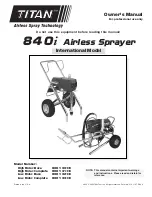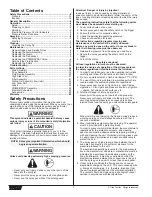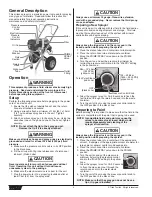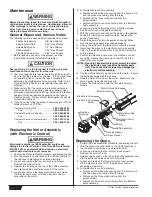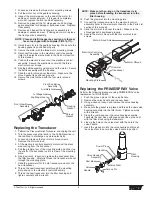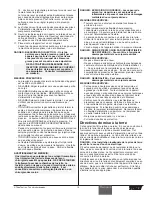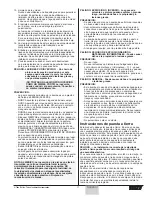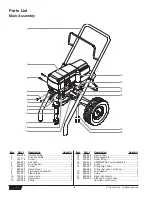
7. Move the PRIME/SPRAY valve up to the SPRAY position.
8. Turn the unit on and set the pressure to minimum by
turning the pressure control knob to the “Min PSI” setting
in the yellow zone.
9. Unlock the gun by turning the gun trigger lock to the
unlocked position.
Ground the gun by holding it against the
edge of the metal container while
flushing. Failure to do so may lead to a
static electric discharge, which may
cause a fire.
10. Trigger the gun into the metal waste
container until the old solvent is gone and fresh solvent is
coming out of the gun.
11. Lock the gun by turning the gun
trigger lock to the locked position.
12. Set down the gun and increase the
pressure by turning the pressure
control knob slowly clockwise into the
green zone. Stop when the pressure
indicator is solid green.
13. Check the entire system for leaks. If leaks occur, turn off
the unit and follow the “Pressure Relief Procedure” in this
manual before tightening any fittings or hoses.
14. Follow the “Pressure Relief Procedure” in this manual
before changing from solvent to paint.
Be sure to follow the pressure relief procedure when
shutting the unit down for any purpose, including
servicing or adjusting any part of the spray system,
changing or cleaning spray tips, or preparing for cleanup.
Painting
1. Place the siphon tube into a container of paint.
2. Place the return hose into a metal waste container.
3. Move the PRIME/SPRAY valve down to the PRIME
position.
4. Turn the unit on and set the pressure to
minimum by turning the pressure control
knob to the “Min PSI” setting in the yellow
zone.
5. Allow the sprayer to run until paint is
coming through the return hose into the
metal waste container.
6. Turn the unit off by moving the pressure control knob to
the OFF position in the black zone.
7. Remove the return hose from the waste container and
place it in its operating position above the container of
paint.
8. Move the PRIME/SPRAY valve up to the SPRAY position.
9. Turn the unit on and set the pressure to minimum by
turning the pressure control knob to the “Min PSI” setting
in the yellow zone.
10. Unlock the gun by turning the gun trigger lock to the
unlocked position.
Ground the gun by holding it against the
edge of the metal container while
flushing. Failure to do so may lead to a
static electric discharge, which may
cause a fire.
11. Trigger the gun into the metal waste
container until all air and solvent is flushed from the spray
hose and paint is flowing freely from the gun.
WARNING
WARNING
Trigger lock
in locked position.
WARNING
12. Lock the gun by turning the gun trigger
lock to the locked position.
13. Turn the unit off by moving the
pressure control knob to the OFF
position in the black zone.
14. Attach tip guard and tip to the gun as
instructed by the tip guard or tip
manuals.
POSSIBLE INJECTION HAZARD. Do not spray without the
tip guard in place. Never trigger the gun unless the tip is
in either the spray or the unclog position. Always engage
the gun trigger lock before removing, replacing or
cleaning tip.
15. Turn the unit on and set the pressure to minimum by
turning the pressure control knob to the “Min PSI” setting
in the yellow zone.
16. Increase the pressure by turning the pressure control
knob slowly clockwise toward the green zone and test the
spray pattern on a piece of cardboard. Adjust the
pressure control knob until the spray from the gun is
completely atomized.
Electronic Pressure Control Indicators
The following is a description of the electronic pressure control
indicators.
Pressure Indicator
The pressure indicator shows the current operating pressure of
the sprayer. It has three different indications: blinking yellow,
solid yellow, and solid green.
Blinking Yellow
When the pressure indicator is blinking yellow, the sprayer is
operating between 0 and 14 bar (200 PSI). A blinking yellow
pressure indicator means:
• The sprayer is plugged in and turned “ON”.
• The sprayer is at priming pressure (little or no pressure).
• It is safe to move the PRIME/SPRAY valve between
positions.
• It is safe to change or replace the spray tip (refer to gun
manual for tip replacement instructions).
NOTE: If the pressure indicator begins blinking yellow
when the pressure control knob is set at a
higher pressure and the PRIME/SPRAY valve is
in the SPRAY position, either the spray tip is
worn, there is a leak, or the sprayer is in need
of service/repair.
Blinking Yellow
0–200 PSI
Solid Yellow
200–1800 PSI
Solid Green
1800–3300 PSI
Motor Running
Indicator
Programmer
Port
Pressure Indicator
Motor Running
Indicator
Programmer
Port
NOTE: Turning the pressure up higher then needed to
atomize the paint will cause premature tip wear
and additional overspray.
WARNING
Trigger lock
in locked position.
© Titan Tool Inc. All rights reserved.
5

